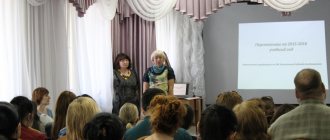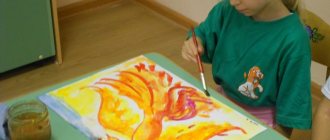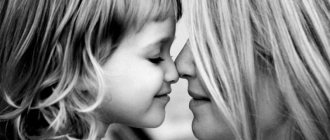Physical development of children in the senior group
Age group: senior.
Educational field: physical development
Goal: strengthening children's health, creating conditions for instilling interest in physical education.
Tasks:
- Wellness
– continue to form correct posture in children;
– create conditions for positive emotions during the event.
- Educational
– improve walking one after another, changing the pace and switching to a soft, mincing step;
– to develop skills in changing formations in threes.
- Developmental
– develop the ability to maintain alignment when walking along a bench with side steps;
– improve the skills of crawling under an arch by rolling from foot to foot, bending over;
– consolidate the skill of energetic push-off and landing on bent legs.
- Educational
– to cultivate interest in physical culture through the plot in educational activities;
– follow the rules of the game.
Type of activity: gaming, motor, communicative.
Form of organization: group, game with speech accompaniment.
Equipment: bench, arc, hoops.
Preliminary work: Children played a variety of outdoor games while walking, in everyday activities, and performed daily morning exercises.
GCD move
Organizing time. The teacher offers to go on an interesting journey, where many obstacles (basic movements) must be overcome along the way, but the children are strong, brave and will certainly overcome them.
I. Introductory part. Line up one at a time. Walking one after another with changes in pace. Normal running with a transition to a small mincing step. Walking and rebuilding in threes in three columns, one at a time.
II. Main part.
- Raising your hands up.
Starting position – basic stance, hands down.
1-hands forward
2-up
3-sided
4-down.
- Turns to the sides with arms raised.
Starting position – kneeling, hands on your belt.
1.3-turns right - left
2.4 – starting position.
- Forward bends
Starting position: sitting on the carpet, hands on your belt.
1.3 – lean forward, touch your toes with your hands
2.4 – starting position.
- Raising legs one at a time
Starting position – sitting, arms supported behind you.
1.3 – raise your right and left leg.
2.4 - starting position.
- "Bike"
Starting position – lying on the carpet, arms along the body. Legs are bent at the knees and pressed to the stomach. At the signal “Let's go!” children perform movements with their legs that imitate riding a bicycle.
- Jumping with alternating breathing exercises.
Starting position - main stance
1.3 – jump right, left.
2.4 - return to the starting position.
Forming a column one after another.
Main types of movements.
- Walking on a bench with an extended step. Goal: maintain stable balance.
- Climbing under the arc. Goal: climb by rolling from one leg to the other, bending over and without touching the arc.
- Jumping on two legs from hoop to hoop. Goal: push off energetically and land on bent legs.
The movements are performed one after another.
Children walk one at a time along the bench at an extra step, then crawl under the arc and perform jumps on two legs while moving forward. Then they stand at the end of the column.
Outdoor game "Sly Fox". Goal: act on a signal, develop attention, run.
III. Final part. Walking in a column one at a time while performing attention exercises. Reflection. The result is in accordance with the goals set.
On the topic: methodological developments, presentations and notes
I provide physical development classes for older children.
Abstract of GCD on physical development.
Notes on the physical education of children of the senior group during a walk in accordance with the Federal State Educational Standard.
Lesson for children 5-6 years old on physical development.
Integration of educational areas: physical development, social and communicative development, artistic and aesthetic development, speech development. Objectives: 1. To form skills and abilities correctly.
Integration of educational areas: “Physical development”, “Social and communicative.
Summary of OOD on physical development in the senior group on the topic “Travel to the country of Sportlandia.”
Approximate volume of educational load in a preschool educational institution, taking into account SanPiN 2.4.1.3049-13 and the draft Federal State Educational Standard for Preschool Education
Approximate volume of educational load in a preschool educational institution
taking into account SanPiN 2.4.1.3049-13 and the draft Federal State Educational Standard
A rational daily routine is the basis for the health and upbringing of children. Strict adherence to the regime helps regulate the child’s basic physiological needs, stability of behavior, teaches organization and activity, and helps maintain stable performance.
Organized educational activities of children of primary and secondary preschool age are carried out in the process of involving them in various types of children's activities: play, cognitive research, perception of fiction and folklore, self-service and basic household work, construction from various materials, visual arts, music. The teacher doses the volume of educational load taking into account sanitary and epidemiological rules and regulations.
Educational activities with children of senior preschool age are carried out in the process of involving them in various types of children's activities, including in the form of classes. Particular attention must be paid to the hygiene of organizing and conducting classes with children, ensuring a rational combination of mental and physical activity, as well as sufficient physical activity of the child during the day. Teachers dose the educational load taking into account sanitary and epidemiological rules and regulations.
According to the current SanPiN 2.4.1.3049-13
The duration of continuous direct educational activity for children from 3 to 4 years old is no more than 15 minutes, for children from 4 to 5 years old - no more than 20 minutes, for children from 5 to 6 years old - no more than 25 minutes, and for children from 6 to 7 years old - no more than 30 minutes. The maximum permissible amount of educational load in the first half of the day in the junior and middle groups does not exceed 30 and 40 minutes, respectively, and in the senior and preparatory groups - 45 and 1.5 hours, respectively. In the middle of the time allotted for continuous educational activities, a physical education session is held. Breaks between periods of continuous educational activity are at least 10 minutes.
Educational activities with children of senior preschool age can be carried out in the afternoon after a nap. Its duration should be no more than 25 - 30 minutes a day. In the middle of directly educational activities of a statistical nature, physical education minutes are held. Educational activities that require increased cognitive activity and mental stress of children should be organized in the first half of the day. To prevent children from becoming tired, it is recommended to conduct physical education, music, rhythm classes, etc.
Age-related educational loads in accordance with SanPiN 2.4.1.3049-13
| Age Criteria | 3-4 years | 4-5 years | 5-6 years | 6-7 years |
| No more | ||||
| 30 min. | 40 min. | 45 min. in the first half of the day | 1.5 hours in the first half of the day | |
| 25 minutes in the afternoon | 30 minutes in the afternoon | |||
| Number of conditional hours (NCH) per week | 10 | 10 | 13 | 14 |
| Number of conditional hours (NCH) per year based on 28 academic weeks | 280 | 280 | 364 | 392 |
| Total astronomical time GCD per week (in hours) | 2 hours 30 minutes | 3 hours 20 minutes | 5 hours 25 minutes | 7 hours |
| Total astronomical time GCD per year (in hours) | 70 hours | 93 hours 20 minutes | 140 hours | 196 hours |
| Maximum permissible volume of weekly educational load according to SanPiN | 2 hours 30 minutes 150 min. | 3 hours 20 minutes 200 min. | 5 hours 50 minutes 350 min. | 10 o'clock 600 min. |
The approximate volume of the weekly educational load at the institution for the 2013 – 2014 academic year. year
(directly educational activities)
| Educational areas | Program area | Name | Time (number of hours per week) | |||
| from 3 to 4 years | from 4 to 5 years | Senior preschool age | ||||
| from 5 to 6 years | from 6 to 7 years | |||||
| Physical development | Development of a culture of movement and health work. Mastering the basic norms and rules of a healthy lifestyle. | Physical Culture | 45 min | 60 min. | 75 min. | 90 min. |
| Cognitive development | Development of a culture of knowledge. Formation of cognitive actions, formation of cognition. | Formation of elementary mathematical concepts | 15 minutes | 20 minutes. | 25 min. | 60 min. |
| Cognitive development | 15 minutes | 20 minutes | 25 min | 30 min | ||
| Social and communicative development | Development of communication and interaction of the child with adults and peers. Development of social and emotional intelligence. | Construction/artwork | 25 min | 30 | ||
| Manual labor | 25 min | |||||
| Artistic and aesthetic development | Development of artistic and aesthetic culture. The formation of an aesthetic attitude towards the surrounding world | Music | 30 min | 40 min. | 50 | 60 |
| Visual activities | 15 minutes | 20 minutes. | 50 | 60 | ||
| Modeling | 15 minutes | 20 minutes. | — | — | ||
| Speech development | Development of a culture of communication. Mastery of speech as a means of communication. | Speech development | 15 minutes | 20 minutes. | 25 | 30 |
| Literacy training | 25 | 60 | ||||
| TOTAL: | 2h. 30 min. | 3 hours 20 minutes | 5 hours 25 minutes | 7 o'clock | ||
| Maximum allowed according to SanPin: | 2 hours 30 minutes | 3 hours 20 minutes | 5 hours 50 minutes | 10 hours |
Variable (modular) part of the program.
In accordance with the priority of the establishment and ensuring equal starting opportunities for pupils, children's interest groups are included in the educational process. Due to the fact that both parts of the Program are recommended to be kept in the general logic and its implementation is carried out during the entire stay of the pupils in the preschool educational institution, circle work can be organized both in the first half of the day and in the afternoon.
The following additional services are provided:
| Development direction | Educational services | Age group | Supervisor |
| 1. Physical | "The big guy" | Senior preschool age (6-7 years) | Physical education instructor 2 sq. category |
| 2. Cognitive-speech | "Why" | Senior preschool age (5-6 and 6-7 years old) | Group teachers |
| "Rechetsvetik" | Senior preschool age (5-6 years) | Teacher speech therapist | |
| "We speak correctly" | Senior preschool age (6-7 years) | Teacher speech therapist | |
| "Zukovichok" | Senior preschool age (5-6 years) | Teacher speech therapist | |
| 3. Artistic and aesthetic | "Yugorchata" | Senior preschool age (6-7 years) | Musical director |
| "Okay" | Senior preschool age (5-6 years) | Musical director |
Children of senior preschool age visit the speech correction room 2 times a week; carried out as individual
as well as subgroup classes. The content of the correctional program “Program for training and education of children with phonetic-phonemic speech underdevelopment” is implemented in individual lessons with children with deviations in speech development.
1. Eastern administrative district. GBOU secondary school No. 1852.
Topics of speeches:
1. “Aspects of the physical development of preschool children in accordance with the Federal State Educational Standard for Education,” senior teacher N. N. Spesivtseva.
2. “Hardening as the basis of physical education and health work in pre-school education”, teachers T.V. Burleeva, A.P. Zhugina.
3. “Implementation of the “Health School” technology project in preschool educational organizations,” teacher T. I. Rebrantova.
4. “Sports corner as a means of activating independent motor activity of preschool children,” teachers T. G. Levkina, S. V. Kazakova.
5. “Project on the theme “We are future Olympians””, teachers I. G. Kazaryan, L. M. Varesko.
6. “Didactic games as a means of developing interest in sports in children of senior preschool age,” physical education instructor L. V. Lebedeva.
7. “Summary of continuous educational activities with children 4–5 years old on the topic “Such different balls”,” physical education instructor L. V. Lebedeva, teacher V. A. Krut.
The event materials can be found at the link: https://drive.google.com/drive/folders/0Bwy77u-Zt1Fwdy1RcmNpMFlLcFk?usp=sharing
2. Eastern administrative district. GBOU School No. 2094.
Topics of speeches:
1. “Health-saving technologies in working with preschool children,” methodologist T. G. Vakhterova, teacher T. A. Lykova.
2. “Psychological health of a teacher. Psychotherapeutic games for self-regulation of the emotional state of teachers,” educational psychologist O. V. Toygildina.
3. Summaries of continuous educational activities:
— in the junior group, physical education instructor N. N. Sharganova, teacher K. E. Stabrovskaya;
- in the senior group, physical education instructor V. A. Batkova.
The event materials can be found at the link: https://drive.google.com/drive/folders/0Bwy77u-Zt1FwdGFJUklGTm95QXM?usp=sharing
3. Zelenograd administrative district. GBOU Gymnasium No. 1528.
Topics of speeches:
1. “Basic educational program of preschool education. Physical development”, senior educators N. M. Balaeva, K. G. Avetisyan.
2. “Teaching children to ski,” teacher A. M. Konyagina.
3. “Teaching preschool children to play hockey,” teachers I. A. Davydova, M. S. Timonina.
4. “Teaching children to skate,” teacher A. A. Tolokonnikova.
5. “Ice paths in kindergarten,” teacher I. V. Zhilina.
The event materials can be found at the link: https://drive.google.com/drive/folders/0Bwy77u-Zt1FwLUwtcnk1VWFyanM?usp=sharing
4. North-Eastern administrative district. GBOU Gymnasium No. 1503.
Topics of speeches:
1. “Modern approach to organizing the motor regime of the day in a preschool institution,” teacher G. V. Matytsina.
2. “Formation of healthy lifestyle values in preschool children,” senior teacher O. V. Labay, teachers S. V. Grishina, Yu. A. Shulaeva.
3. “Psychological health of children and ways to preserve it,” educational psychologist V.V. Selezneva, teacher V.V. Yatsko.
The event materials can be found at the link: https://drive.google.com/drive/folders/0Bwy77u-Zt1FweE9sUGJ6M3V2ZWM?usp=sharing








